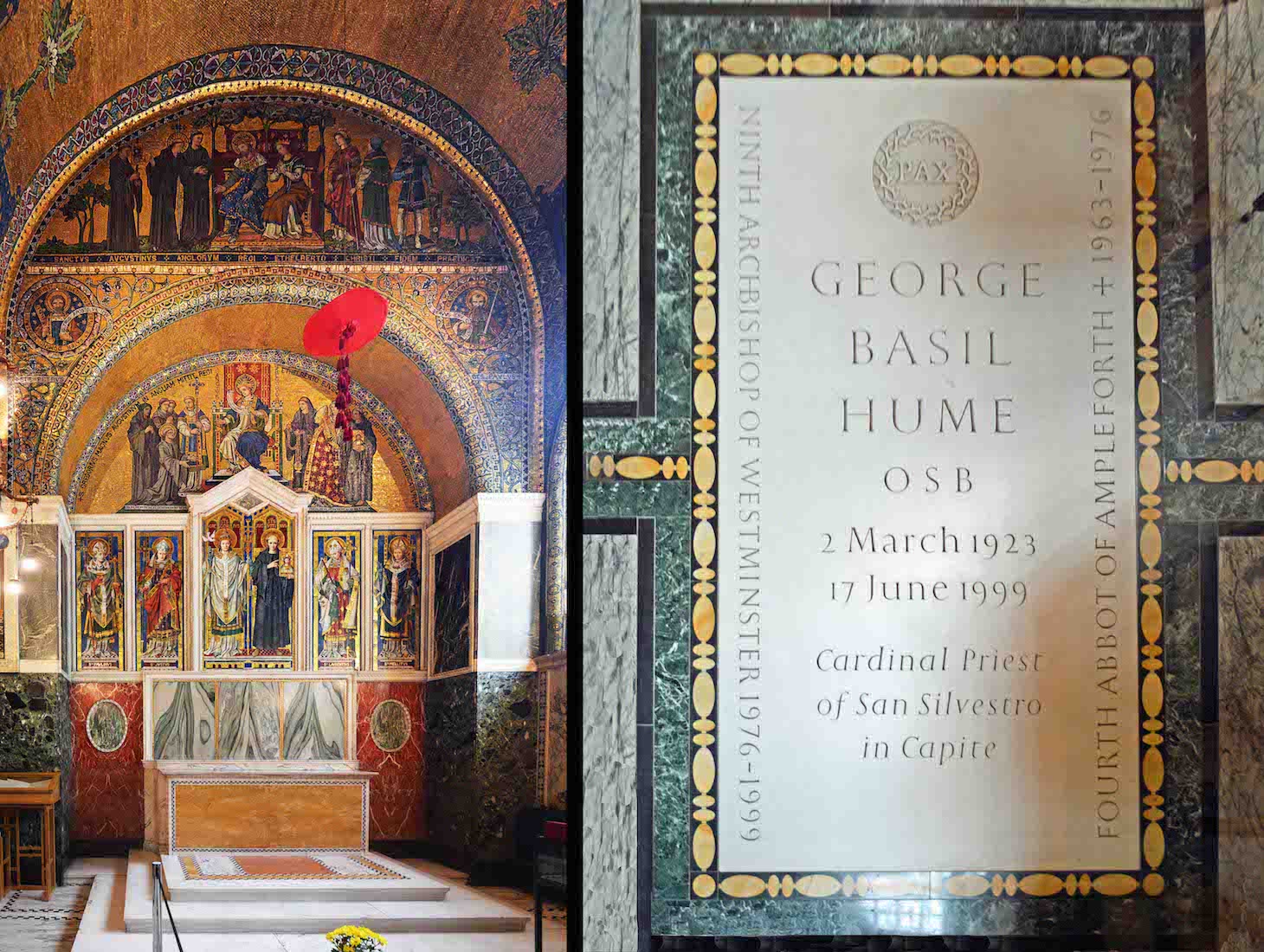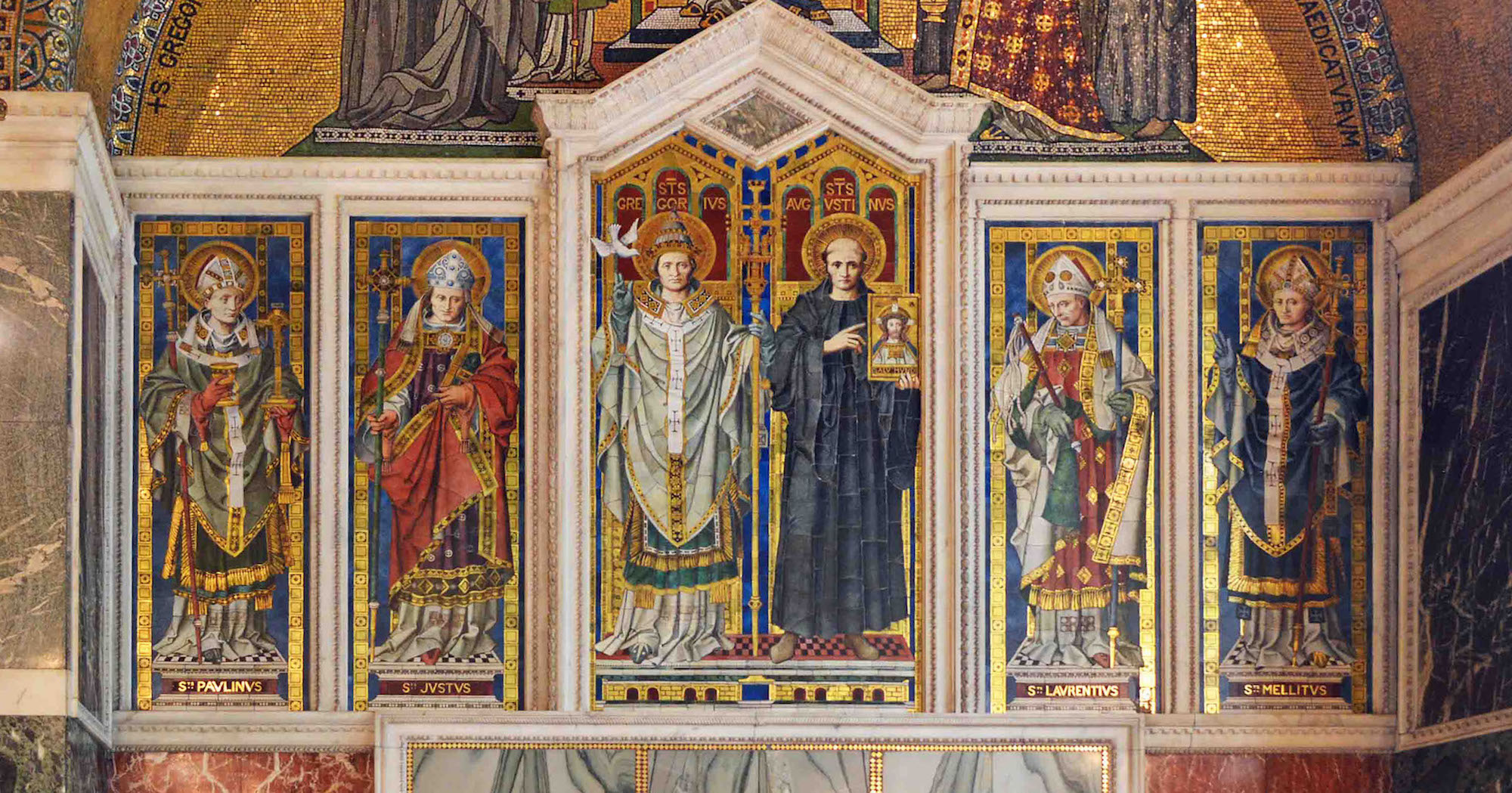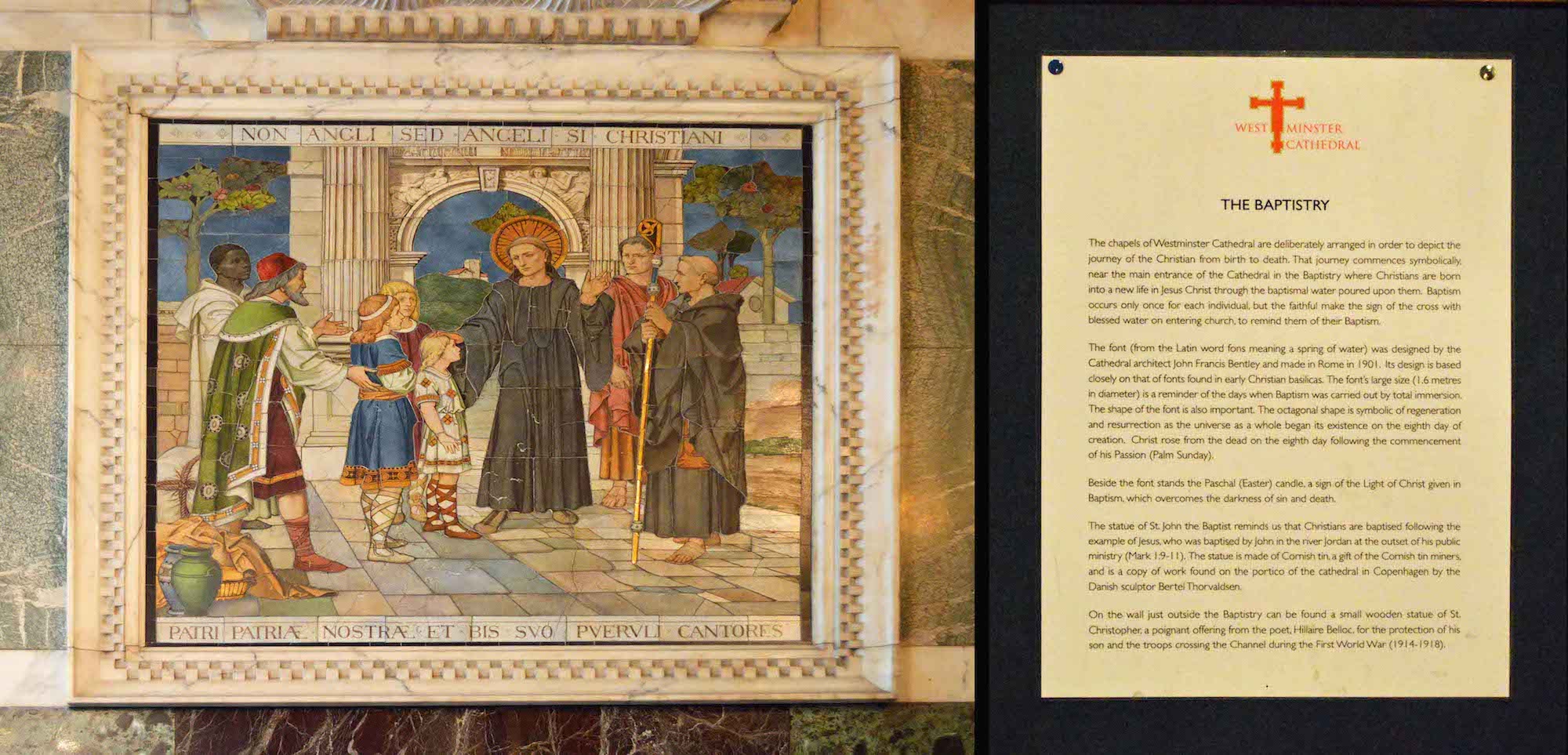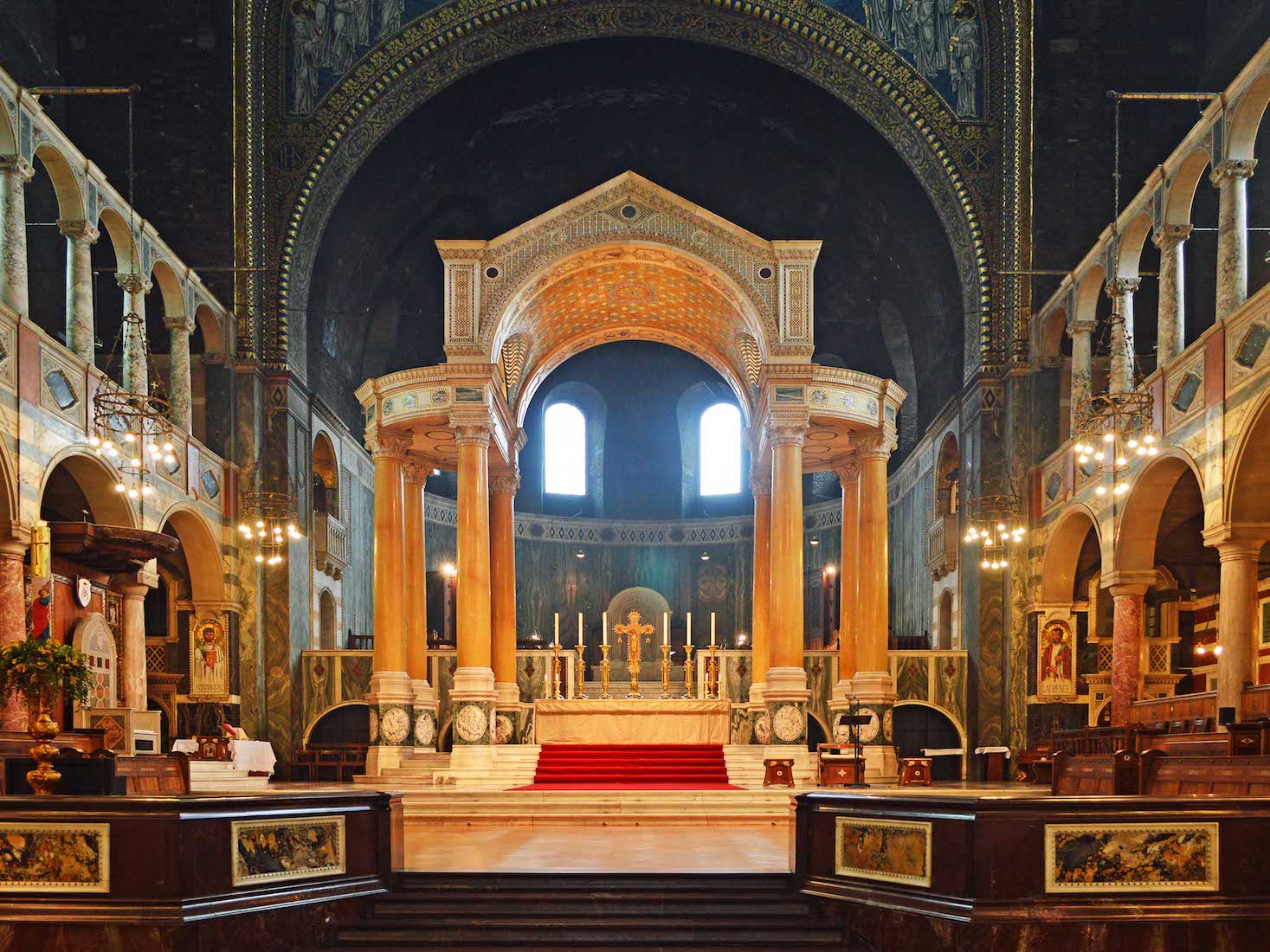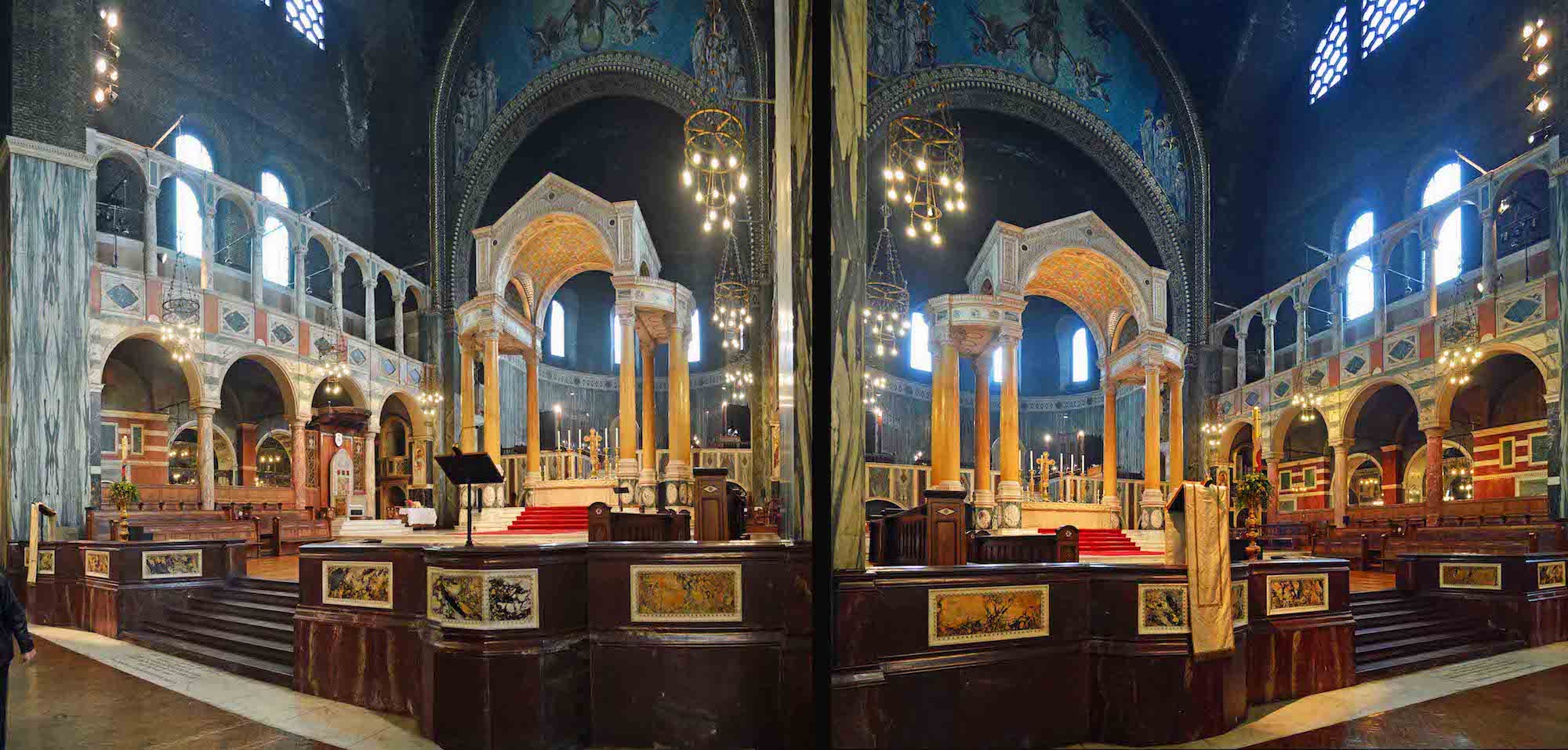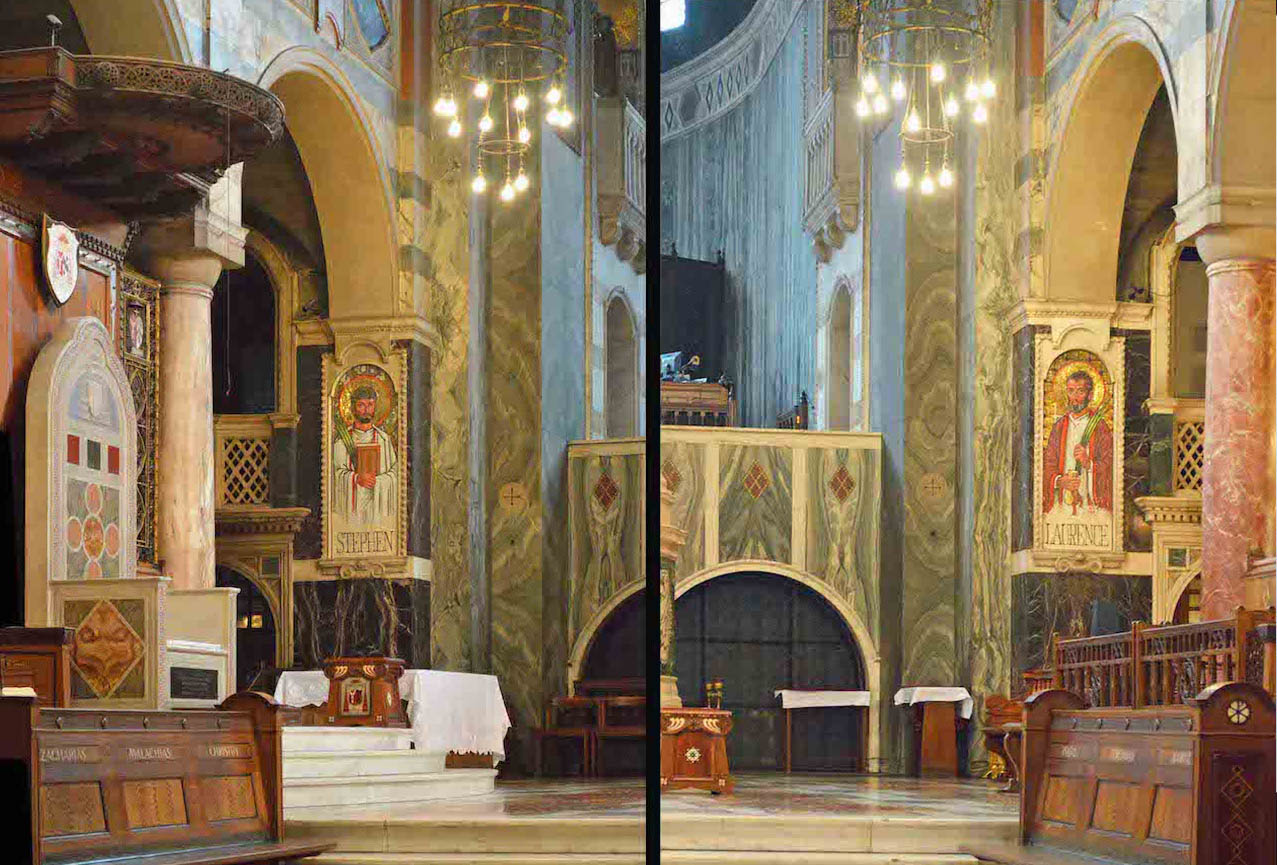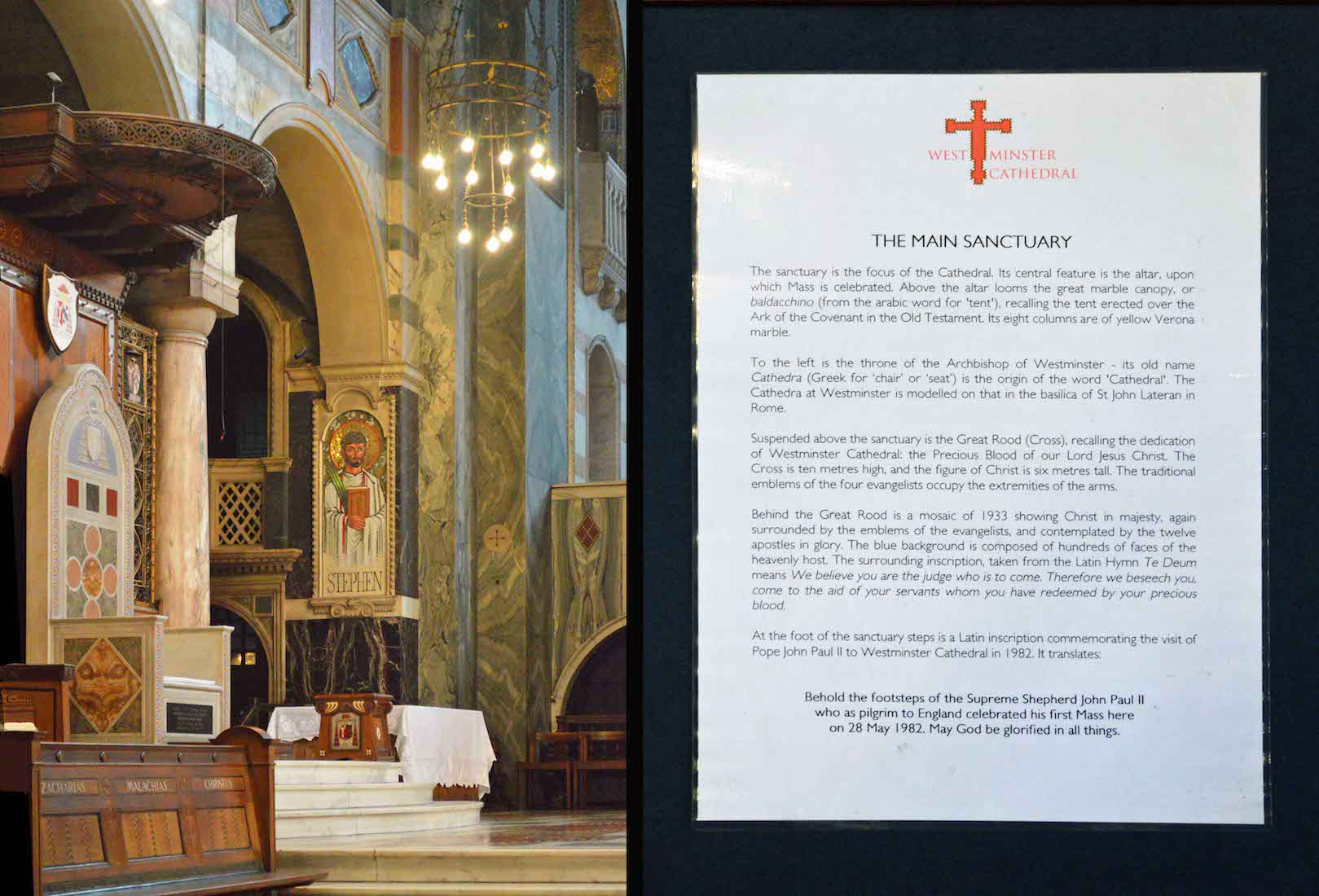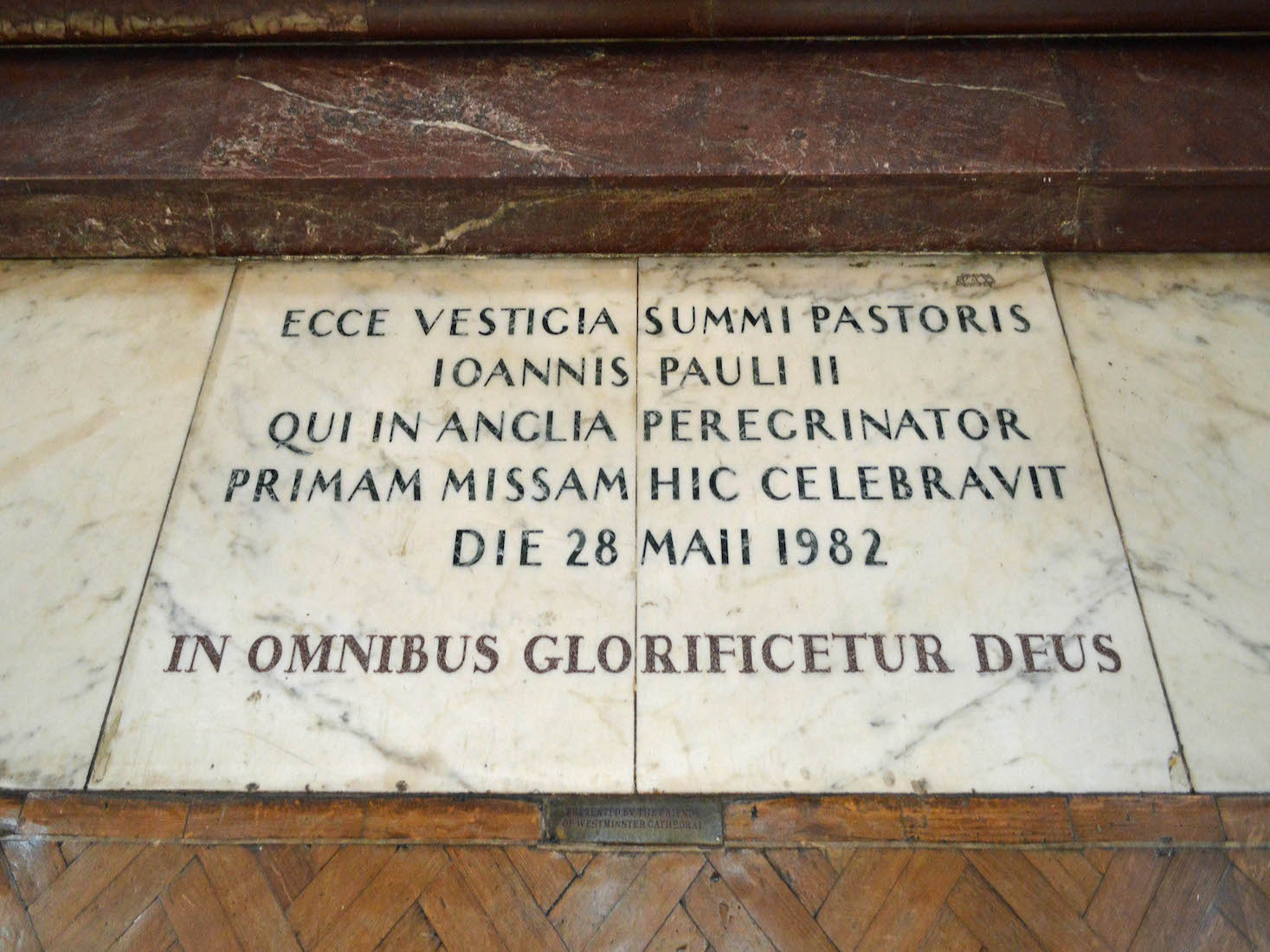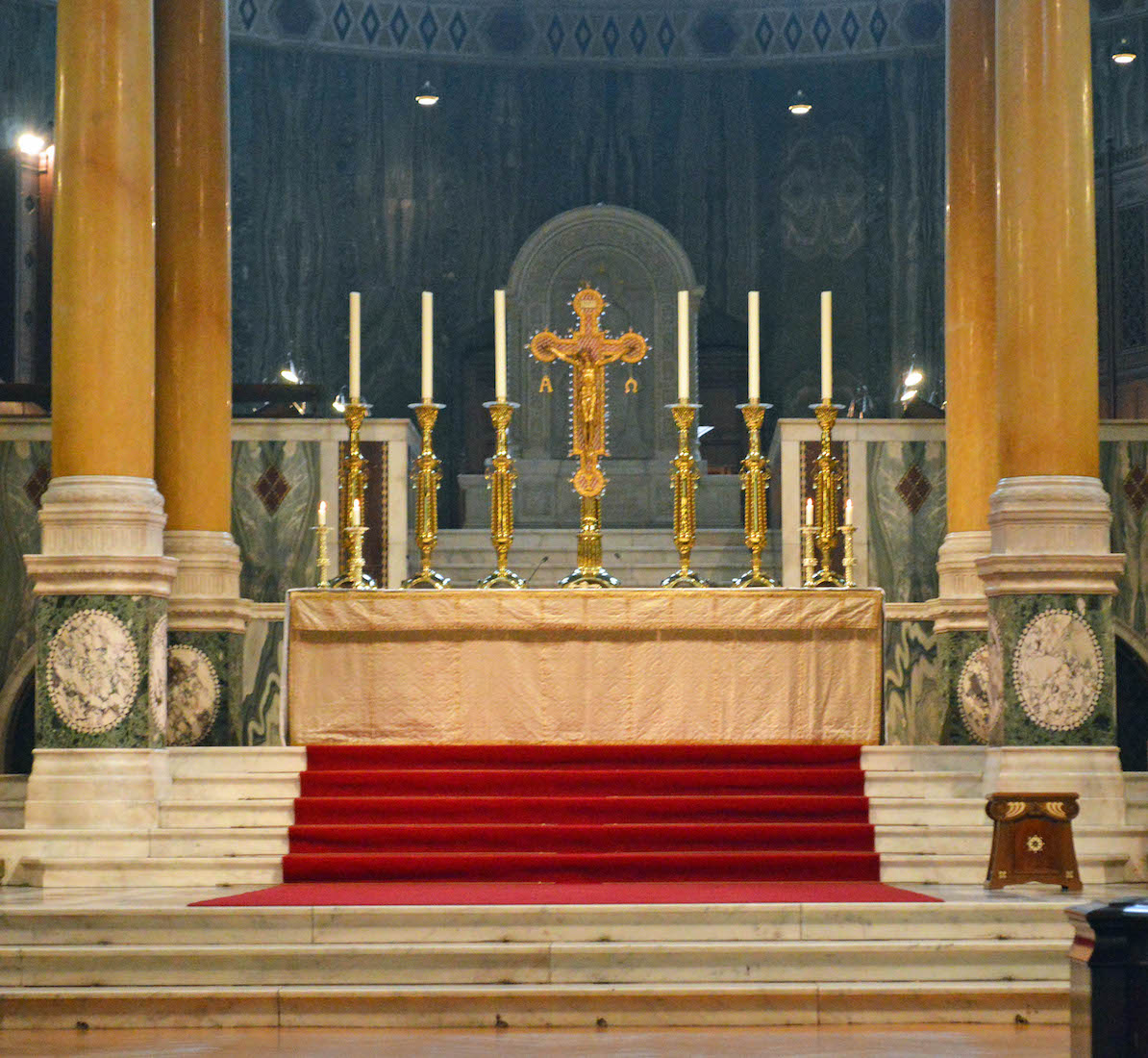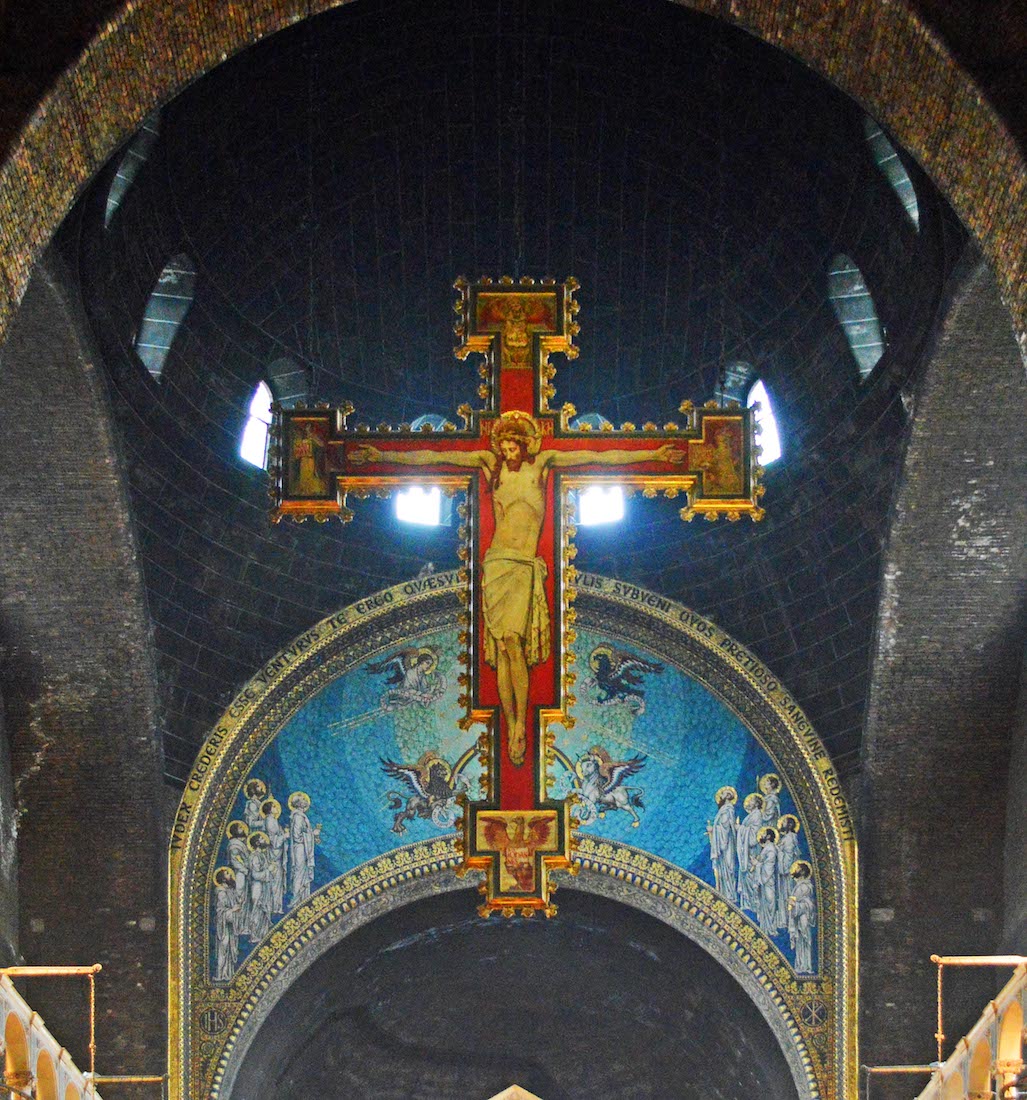
This is the Chapel of St Andrew and the Saints of Scotland. St Andrew is the patron saint of Scotland. Four of the marbles and granites in this chapel come from Scotland, and the thistle (the emblem of Scotland) can be seen at the top of the chapel grille (not shown here). On either side of the altar are depicted Scottish saints: Ninian, Margaret, Bride and Columba. High above the altar, St Andrew’s diagonal cross can be seen. PLAN
42. ST PATRICK’S CHAPEL
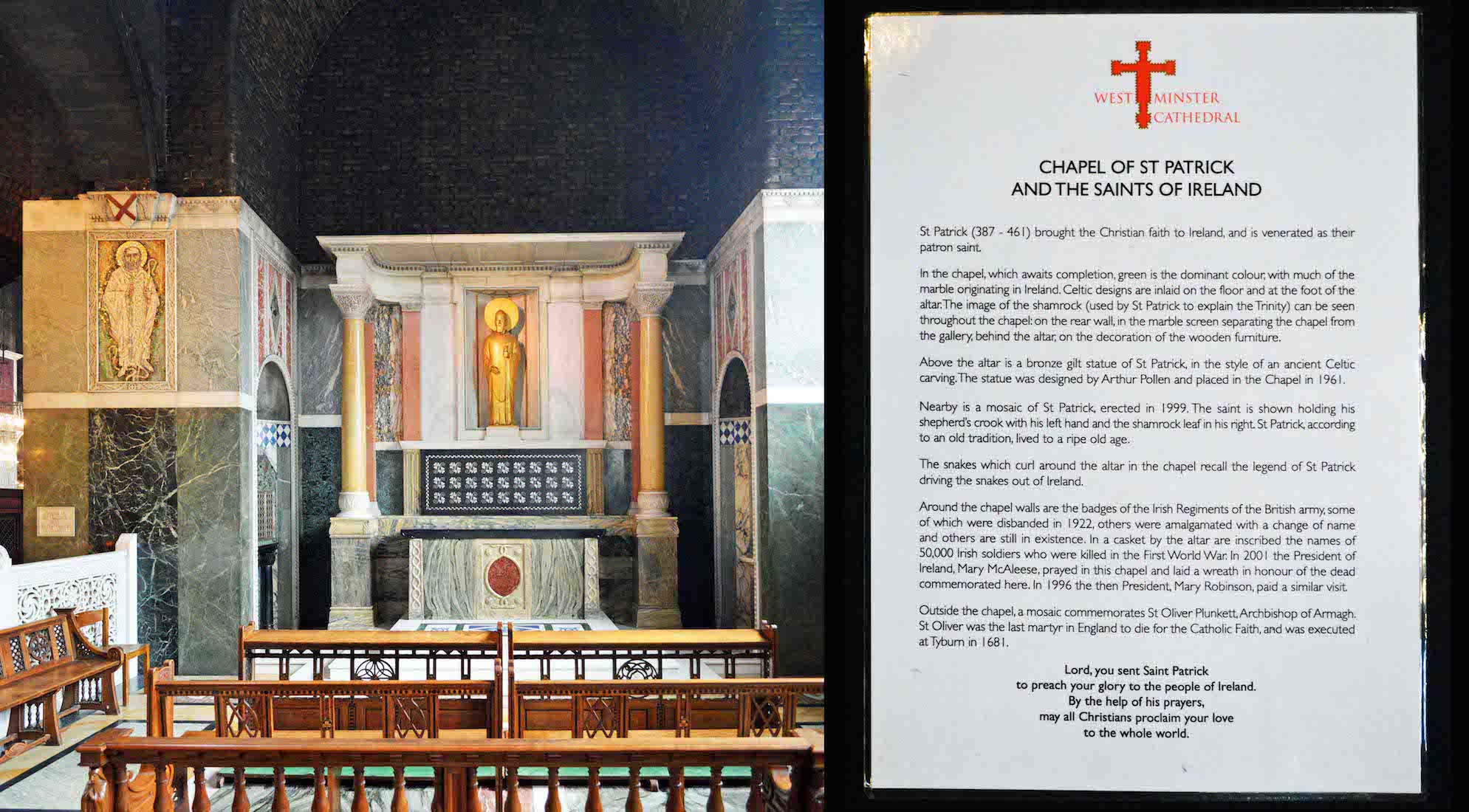
This is the Chapel of St Patrick and the Saints of Ireland. St Patrick (AD 387 – 461) brought the Christian faith to the Irish people, and is venerated as Patron Saint of Ireland. Famously, he used the shamrock to illustrate the Trinity, and many shamrocks can be seen in this Chapel. Above the altar is a bronze gilt statue of Patrick, and nearby is a mosaic of the saint. The snakes on the altar recall the legend of Patrick driving the snakes out of Ireland.
43. CHAPEL OF ST GREGORY AND ST AUGUSTINE
This chapel is dedicated to the saints who first brought the gospel to England. On the ceiling are portrayed early saints of England: St Wilfrid of York, St Benedict Biscop, St Cuthbert of Lindisfarne, St Edmund of East Anglia, St Bede the Venerable, and St Oswald of Northumbria. Two great Catholic leaders are buried in this chapel: Bishop Richard Challoner (1691 – 1781), and Cardinal George Basil Hume (1923 – 1999) who was the ninth Archbishop of Westminster.
44. CHAPEL SAINTS
Directly above the chapel altar are Pope St Gregory with the dove of the Holy Spirit, and St Augustine with a picture of Christ which he brought to England. On the left are St Paulinus and St Justus, and on the right St Laurence and St Melitus, companions and successors to St Augustine.
45. REGISTER OF DECEASED PAPAL KNIGHTS
Pontifical decorations are the titles of nobility, orders of Christian knighthood and other marks of honour and distinction which the papal court confers upon men of unblemished character who have in any way promoted the interests of society, the Church, and the Holy See. There are various Orders of Knighthood. These are: Supreme Order of Christ; Order of Pius IX; Order of St. Gregory the Great; Order of St. Sylvester; Order of the Golden Militia, also called of the Golden Spur; Order of The Holy Sepulchre.
46. POPE GREGORY MOSAIC
A panel on the right of the entrance to this chapel depicts St Gregory in the market place in Rome. Asking the origin of some slave children, he was told they were Anglo-Saxons. Above are the famous words of his reply: ‘Not Angles, but angels, if they were Christians’.
47. BAPTISTRY
As often happens, the Baptistry is placed near the entrance to the Cathedral, symbolizing entry into the Christian life and the Church through the waters of baptism. The large octagonal font is 1.6 metres in diameter, and was designed in 1901 by John Francis Bentley. From left to right we have an image of St Christopher, John the Baptist, the font, and St Anthony. The font is designed for baptism by immersion, but that is not practised at Westminster. We now approach the sanctuary.
48. SANCTUARY AND APSE
Above the altar towers the great marble canopy or baldacchino. This word comes from the Arabic word describing a tent. There is reference here to the tent erected over the Holy of Holies in the Old Testament. In the background is the apse – rather hidden from public view, but the place from where the choir sings. In the centre, at the entrance to the apse is a carved stone representation of Christ holding the chalice of his precious blood.
49. NORTH AND SOUTH SANCTUARY
These two views show the expanse of the sanctuary and the rich marble adornment of the walls. On the North side (left) we notice the pulpit which is regularly used for services, and the impressive bishop’s chair, or cathedra. On the South side stands a lectern, likely used for notices and reading of the Scripture.
50. SANCTUARY SIDES
To the sides of the sanctuary are fine (choir) stalls made of Austrian oak and walnut. These provide seating for the Cathedral canons, chaplains, altar servers and readers. There is also a mosaic on either side – of St Stephen at left and St Laurence to the right.
51. CATHEDRA
The throne of the Archbishop of Westminster is called ‘cathedra’ in Latin, and is the source of the word ‘cathedral’. The Westminster cathedra is a smaller copy of that in the basilica of St John Lateran in Rome – the Pope’s own cathedral, and the seat of his authority as the Bishop of Rome. This cathedra was a gift to Cardinal Vaughan from the Catholic bishops of England and Wales in 1902.
52. MEMORIAL STONE
At the foot of the sanctuary steps is a Latin inscription commemorating the visit of Pope John Paul II to Westminster Cathedral in 1982. In English, the text reads: ‘Behold the footsteps of the Supreme Shepherd John Paul II, who as a pilgrim to England celebrated his first Mass here on 28 May 1982. May God be glorified in all things’.
53. ALTAR
This nave altar is the working centre of the Cathedral. It is the natural focus point for the congregation, and it is from here that the Mass is administered. On the altar are six golden candlesticks, and a golden crucifix with the letters ‘Alpha’ and ‘Omega’ suspended from the arms, and a chalice at the base.
54. ROOD CROSS
Suspended high above the sanctuary is the great rood cross of painted and gilt wood. The cross is nine metres high and weighs two tonnes; the figure of Christ is six metres tall. The traditional emblems of the four evangelists occupy the extremities of the arms of the cross. More difficult for the public to see, on the reverse side of the cross is the figure of Mary as Our Lady of Sorrows, a sword piercing her heart in fulfilment of Simeon’s prophecy. This completes our tour.
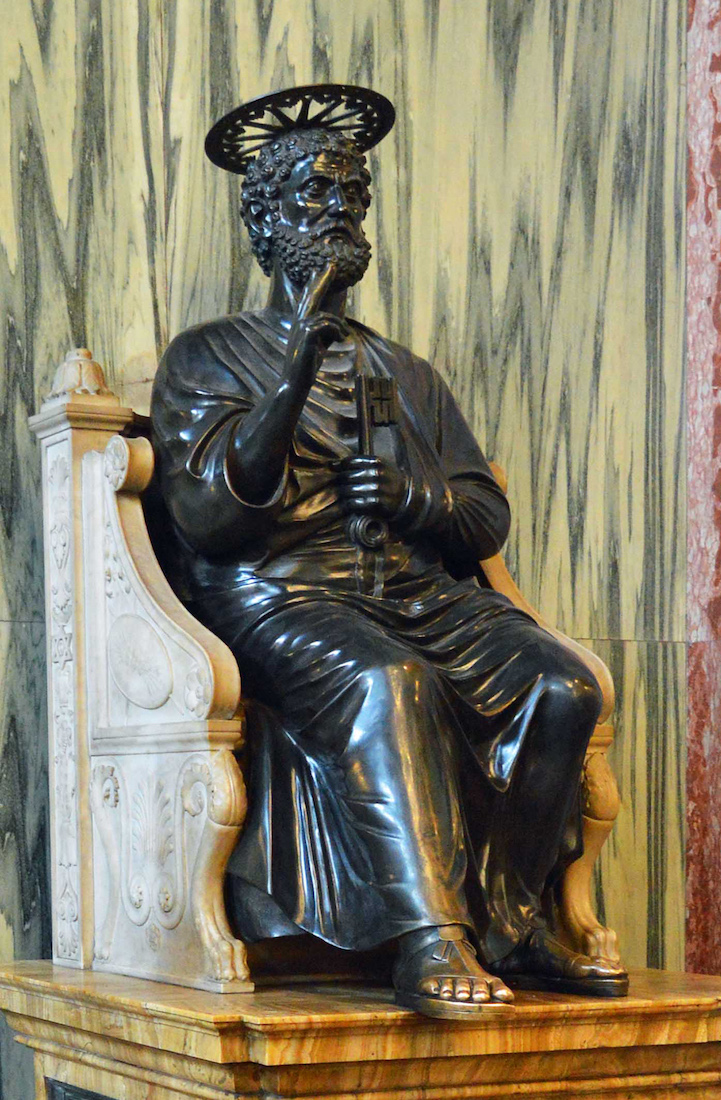
CONCLUSION
I hope you have enjoyed visiting Westminster Cathedral with me. I found it quite overwhelming in its size and decoration. In fact I am disappointed with this website, as I like these cathedral sites to be fairly complete. The allotted half day to photograph Westminster was clearly inadequate!
I am happy to receive constructive comments or corrections concerning this website. The best websites are the ones which have no errors! I am grateful to my wife Margie who came with me, and who has proof-read these pages.
The photographs on this site, with one or two exceptions, are all mine. However, much of the text is not original. I wish to acknowledge my indebtedness to the ever helpful Wikipedia, and also to the Cathedral booklet ‘Westminster Cathedral’ – an excellent booklet which unfortunately fell apart when it was first opened!
The link for the Cathedral website is:
http://www.westminstercathedral.org.uk/
My photographs which appear on this site can also be found in higher resolution at:
https://www.flickr.com/photos/paulscottinfo/sets/
Paul Scott Site created 07 / 2017; reformatted 05 / 2020.

